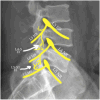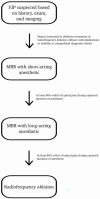Chronic Low Back Pain: History, Symptoms, Pain Mechanisms, and Treatment
- PMID: 39063567
- PMCID: PMC11278085
- DOI: 10.3390/life14070812
Chronic Low Back Pain: History, Symptoms, Pain Mechanisms, and Treatment
Abstract
Chronic low back pain (cLBP) is the most frequently reported cause of years lived with disability. Identifying the anatomical structures or dysfunction contributing to patients' symptoms is critical to guiding treatment. The etiology of back pain and differential diagnosis is often broad, ranging from non-degenerative cLBP (trauma, tumor, inflammation, infection, etc.) to degenerative (also described as nonspecific) cLBP. After eliminating suspicion for more insidious causes of cLBP, a thorough investigation can be conducted in an attempt to identify a source of degenerative cLBP. Degenerative cLBP can originate from many sources, and a detailed understanding of the structures potentially involved is invaluable for an accurate diagnosis. This review article aims to provide a broad overview of the utility of clinical history, physical exam findings, imaging findings, and diagnostic procedures in identifying the cause of patients' cLBP. We provide a framework to help guide clinicians by dividing the structures into groups as follows: anterior vertebral column, posterior vertebral column, and extra-vertebral pain. For each condition listed, we touch on the treatment options that can be considered.
Keywords: axial low back pain; chronic low back pain; discogenic low back pain; lumbar facet arthropathy; lumbar pain; lumbosacral degenerative disease; mechanical low back pain; sacroiliac joint; vertebrogenic low back pain.
Conflict of interest statement
The authors declare no conflict of interest.
Figures


References
-
- GBD 2017 Disease and Injury Incidence and Prevalence Collaborators Global, regional, and national incidence, prevalence, and years lived with disability for 354 diseases and injuries for 195 countries and territories, 1990–2017: A systematic analysis for the Global Burden of Disease Study 2017. Lancet. 2018;392:1789–1858. doi: 10.1016/S0140-6736(18)32279-7. Erratum in: Lancet 2019, 393, e44. https://doi.org/10.1016/S0140-6736(19)31047-5 . - DOI - PMC - PubMed
-
- Agence Nationale d’Accréditation et d’Evaluation en Santé . Diagnostic, Prise en Charge et Suivi des Malades Atteints de Lombalgie Chronique. ANAES; Paris, France: 2000.
-
- Manchikanti L., Boswell M.V., Singh V., Benyamin R.M., Fellows B., Abdi S., Buenaventura R.M., Conn A., Datta S., Derby R., et al. Comprehensive evidence-based guidelines for interventional techniques in the management of chronic spinal pain. Pain Physician. 2009;12:699–802. doi: 10.36076/ppj.2009/12/699. - DOI - PubMed
Publication types
LinkOut - more resources
Full Text Sources

